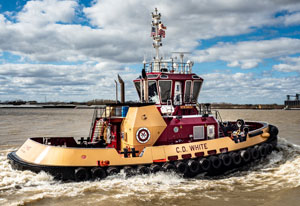For nearly four years, E.N. Bisso & Son’s Gladys B. was the lone z-drive tugboat designed by Robert Allan Ltd. working the Mississippi River. Now, it has some company.
Eastern Shipbuilding of Panama City, Fla., delivered the 80-by-38-foot C.D. White in January 2020, and as of April 2020 was building a sister tug. Both are robust RApport 2400-series tugboats outfitted for ship handling and ocean towing.
“It’s a go-anywhere tug,” said Mike Killelea, E.N. Bisso’s port captain.
By that, he meant ship assist and escort duties over 230 miles of the Mississippi River from Pilottown near the river’s mouth to Baton Rouge, and ocean towing primarily in the Gulf of Mexico and the Atlantic Coast.
“The tug is very stable with plenty of power and is the perfect size,” said Capt. Craig Henderson. “This tug will handle any ship at any place on the Mississippi River.”
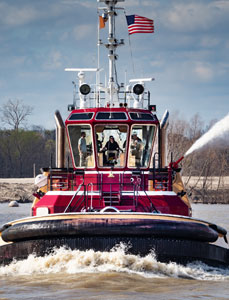 |
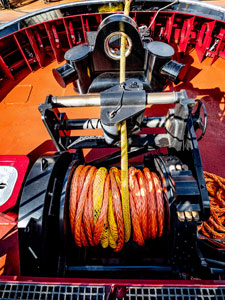 |
|
|
C.D. White is equipped with a 4-inch Stang remote-controlled fire monitor, left. The tug's Markey single-drum DEPCF-42 winch, right, is spooled with 400 feet of Samson Saturn-12 line. |
||
The 5,100-hp C.D. White is something of a sister tug to Gladys B., acquired by E.N. Bisso in 2016 from Signet Maritime of Pascagoula, Miss., which built the vessel at a company yard. E.N. Bisso decided to build its new tugs with the same dimensions and general layout — albeit with some customizing from Robert Allan Ltd. and Eastern Shipbuilding. The vessel also meets Coast Guard Subchapter M standards.
“Our new boats were designed to meet escort standards, but the keel was changed to allow the boat to work well with the Mississippi River’s high river current and still ride well offshore,” said Mike Vitt, an E.N. Bisso vice president.
In addition to ship-handling work in the Lower Mississippi, C.D. White can be deployed for escort or ocean towing work in the Gulf of Mexico, Vitt added. Its skeg is 40 percent smaller than that on Gladys B., which was designed for ship-escort work.
“C.D. White has to work in the strong currents on the Mississippi year-round, and therefore one thing we did was limit the area of the skeg in order to give it better maneuverability when handling ships in the river currents,” said Jamie McCarthy, project manager for Robert Allan Ltd.
Although they share the same pedigree, there are some notable differences between Gladys B. and C.D. White. The power plant is just one example. C.D. White is powered by twin Tier 4 Caterpillar 3512E mains, compared to Tier 3 MTU units on the earlier tug.
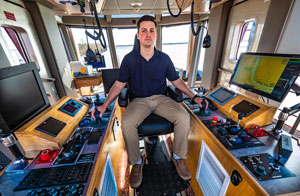 |
|
Capt. Craig Henderson helming C.D. White. |
“Our experience with the various Caterpillar 3512 and 3516 plants on our tugs showed that, for our purposes, the 3512Es were the right choice for us,” Vitt said. Caterpillar engines also are more familiar to the crews and personnel operating and maintaining them.
The two Caterpillar 3512E Tier 4 EPA mains supplied by Louisiana Cat are shafted to Kongsberg/Rolls-Royce US 205-P20 z-drives. The tug generates 67.5 tons of bollard pull, and can hit 15.5 knots running light. Two 99-kW John Deere generators provide electrical power.
Another change was to move from raw-water cooling to keel cooling.
“Gladys B. has raw-water heat exchanger cooling for the main machinery,” McCarthy said. “Although this works fine in the Gulf of Mexico, the Mississippi River tends to have a lot of debris, which can sometimes clog the strainers. For C.D. White, grid coolers mounted in recesses in the hull were used for the machinery cooling.”
The navigation light system designed by JBOX of Harvey, La., is another difference. The new system can switch the navigation lights while towing in reverse. Killelea borrowed the idea from Mike Nigro, a vice president with G&H Towing in Galveston, Texas.
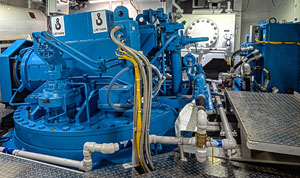 |
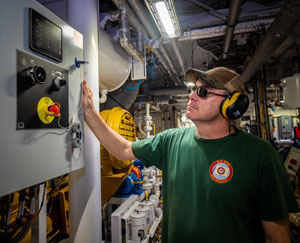 |
|
|
C.D. White’s 2,550-hp main engines are paired with Kongsberg/Rolls-Royce z-drives. Chief engineer Chris Lambert, right, demonstrates features on the Cat 3512 engines. |
||
An ASD tug towing another vessel — say, a ship in distress as opposed to standard escort and assist functions — with a line up from the hawser winch on the bow, tows in reverse. In that scenario, the navigation lights are presented incorrectly. The modified JBOX system corrects the problem.
Having reworked the fendering supplied by Schuyler Companies on Gladys B. to suit the tug’s mission assisting ships on the Mississippi River, McCarthy said they further improved the fendering on the new tugs to provide better side protection and stand-off from vessels.
A 40-hp Markey Machinery DEPCF-42 HS single-drum electric hawser winch and a Smith Berger bow staple with muscular side bitts dominate the foredeck. The winch is wound with 400 feet of Samson 2-5/8-inch Saturn-12 soft line.
The compact design of the RApport 2400 has limited space on the aft deck. The winch and H-bitt on Gladys B., fitted for barge towing on the hip, were not well suited to the new tug’s mission. These were replaced by a stern tow bitt, a Markey capstan and a 90-ton Washington Chain & Supply tow hook in a stacked configuration. The result is a significantly smaller equipment footprint, while maintaining redundancy for towing and gear retrieval functions with an optimal pivot point location.
C.D. White is configured to tow in three different ways: from the bow with the Markey winch; with the bow staple, which has bitts that are rated for 150 tons of static bollard pull; or from the stern with the tow hook.
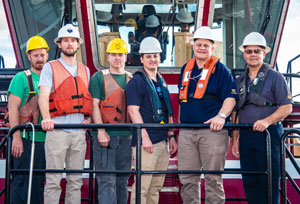 |
|
The crew aboard C.D. White (from left): OS Kevin Johnson, mate Kyle Taylor, chief engineer Chris Lambert, Capt. Craig Henderson, Port Capt. Mike Killelea and port engineer Dwayne Brady. |
The new tugs are equipped with six fixed-mount CCTV cameras and one PTZ (pan-tilt-zoom) camera. These monitor the engine room, z-drive room, and stern and forward deck areas. The PTZ camera is mounted high on the mast and remotely operated from the wheelhouse.
Most tugboats are a second home for crew members, making comfort and amenities an important element in the design and construction. Henderson, impressed with how quietly the tug runs, is equally impressed by the bridge, his third home. “The windows are outstanding,” he said. “There is great visibility forward and back. All of the systems are at your fingertips.”
The Bisso name spans five generations, beginning with founder Capt. Joseph Bisso. The first vessel was a rowboat used to ferry people across the Mississippi at New Orleans. In 1946, Capt. Edwin Napoleon Bisso, with six tugboats, formed E.N. Bisso. Today, the company boasts seven ASD tugs in its 14-vessel New Orleans fleet. Three conventional tugboats are based at the company’s Gulfport Towing fleet in Gulfport, Miss. E.N. Bisso Canaveral, in Port Canaveral, Fla., runs two tugboats, including a 5,000-hp ASD vessel.
C.D. White is the second tug named for Cornelius Dee “Jack” White Jr., an E.N. Bisso owner who also married the company’s then-president, Beverly Bisso White. He was instrumental in E.N. Bisso’s management and growth through the 1970s.
A. Thomas Higgins, the second tug in the series due for delivery later this year, is named for a current E.N. Bisso owner, A. Thomas “Tommy” Higgins.

